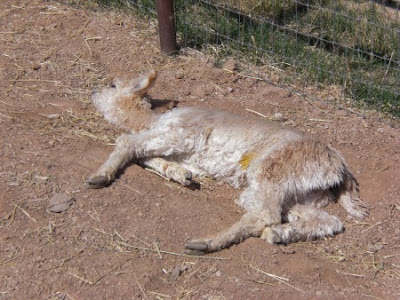 |
| This dog "turnout coat" or blanket is secured with velcro in the front and underneath. This means that application and removal can be quick and effortless. Changing a coat for washing is easy too. This can make an incredible difference in the life of a dog. (Picture: www.picclick.com ) |
This week has been a labor intensive one. Our Siberian Husky is still alive and seems to be doing well, but is fifteen years old now. Two of our alpacas are
five years beyond normal life expectancy. Elderly animals require careful watching. I have other dogs who are fourteen years of age, along with the complement of younger animals who also live here. In extremely cold weather young animals can usually make the adjustment when water freezes and the amount of water they can take in before it does is diminished. Elderly animals don't have such flexibility. Their tolerance to heat, cold, and changes in feeding and water is diminished. Bad weather for kennel or barn dwelling animals can be fatal, and this means that those of us who are their caretakers need to become even more diligent and more attentive to their needs. Consequently, it is sometimes necessary here to change dog water buckets every two to three hours in cold weather, and to consider Delongi oil space heaters in some circumstances. There are electric buckets for animals but for the number of animals here the total would not only be cost prohibitive, but I do not have enough safe outlets for such an undertaking. So, the relatively rare occurrence of extremely cold weather with ice and lots of snow simply makes it a labor intensive process for me. Some dogs benefit from wearing coats in cold weather, just as horses do.
No, I don't bring most animals into the house in cold weather. My daughter has a young Pomeranian who stays with us sometimes. This dog wears a coat when she goes for a walk, and she would not be able to stay in a kennel for anything other than temperate days. However, German Shepherds, Labrador Retrievers, Siberian Huskies, Border Collies, alpacas, horses, etc. are all quite capable of outdoor living if attention is paid to their housing and to weather concerns.
All animals who spend large amounts of time outside need proper housing. Housing needs to be draft free and insulated in Winter, and secure from precipitation. In Summer, there needs to be adequate ventilation and shade. In our location, Summer ventilation and shade is often the more difficult nut to crack. We also have multiple outdoor coats for each dog. Some of them have never worn one, but if they become elderly, their ability to tolerate even the rare sub-zero temperatures here become diminished. Their comfort and activity level is much better when they have a coat. I keep multiples so that one could be washed while another is on a dog. How can I afford thirty large sized dog coats ? Quality dog coats are quite expensive during Winter, but sell for very little money in the off season or when certain color schemes are no longer in vogue. The XXL brown and pink print might not be a top seller, but the dog wearing it overnight is awfully happy to have it.
http://www.cleanrun.com/index.cfm/product/649/foggy-mountain-turnout-dog-coats.htm
http://equestrian.doversaddlery.com/saddlery/dog-turnout-coat
Wherever you are, I hope you are having a safe and happy Winter and that you are giving thought to caring for the animals that are in your own charge. Stay warm and stay safe !








